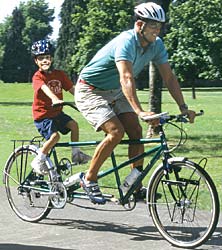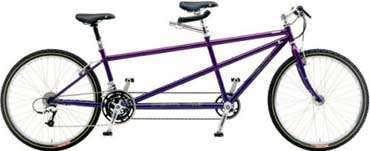Shopping For A Tandem
 |
Tandems Are Two Much Fun!
Whether you enjoy cruising sweet singletrack, logging major road miles, simply coasting around the neighborhood, or all-out competition, doing it on a tandem is double the fun! |
Why? Because, bicycles built for two are faster, more stable on descents, have two fewer tires to flat (compared to two single bikes), attract more attention and allow riding together, regardless of differences in ability.
Twice The Fun
It's this last point that experienced tandem teams love the most. Riding double, no one gets left behind! He can hammer and she can just spin the pedals taking it easy. In this way, both riders get the ride/workout they want. For couples with different skill levels, riding tandems is like eating your cake and having it too!
Another wonderful advantage is being able to communicate so easily because you're seated so closely. Tandems also make great "tractors" for pulling child or cargo trailers. And, when your kids are tall enough, you can install a "kid-back," also known as a child stoker kit. This device raises the rear crankset so children can ride along and help pedal (look closely at how the boy is pedaling in the photo above).
The tandem ride is nothing short of exhilarating. Twofers these days are light, efficient and fast. You can choose models made from high-end steel, aluminum, titanium, and even carbon. Because there's a second engine, with no increase in frontal area, tandems easily outpace singles on flat straight roads. And, on downhills, they flat out fly (which is why tandem brakes are so powerful).
And surprisingly, contrary to popular opinion, tandems can climb, too. An experienced, synchronized team can scale hills as well as any single rider, partly because today's light, thoroughbred tandems weigh less than two high-quality singles.
|
Why Tandems Are Tops | |
|
PROS |
CAVEATS (easily overcome) |
|
no one gets left behind |
bumps can surprise the stoker if not warned |
|
faster & more stable on downhills |
there's a learning curve to harmonious tandemming |
|
half the flat-tire risk as two singles |
more bike-storage room required |
|
ride and talk without yelling |
on group rides, everyone tucks in behind you |
|
one can relax and enjoy the view |
sneaky stokers can soft pedal while you do all the work |
|
stoker can pass food to the captain |
may need a special bike rack for your car |
|
higher speed / same effort |
people point and laugh when you ride it alone to get your friend |
|
both riders get great exercise |
bean burritos |
|
two motors to fight headwinds |
|
|
better upper-body workout |
|
From tourers, to beach cruisers, to full-suspension mountain bikes, two-seaters come in as many varieties as other bicycles. So, in choosing one, it's helpful to think about where and how you'll ride and who you might ride with (joining other tandem teams is a blast because two of the four riders can concentrate on the conversation -- even refer to route slips, Palm Pilots, etc!).
Often, you can decide by the type of single bikes you ride. For example, if you're mountain bikers who spend weekends exploring local trails, riding them on your new off-road tandem will be thrilling and a whole new experience. And, you'll be astounded how the rear wheel sticks like glue to steep climbs with two of you onboard.
Keep in mind that once you get a tandem and realize how much fun it is to ride, you'll probably want to use it every chance you get. A tandem rolls right along, too, so even on a "mountain-bike" tandem, you'll be able to keep up with single road bikers on pavement (assuming they're not a lot fitter than you).
Tandems are beautiful bicycles and many buyers enjoy selecting and customizing their new machine with upgrades such as suspension seatposts, cyclo-computers, disc brakes, bags, bells, etc. Matching jerseys are popular with husband-and-wife teams (photo). We're always happy to discuss the possibilities.
|
|
Frame Types
In the sixties and seventies, when available tandems were few and far between, there were some flexy flyers that gave two-up bicycles a bad reputation. These bicycles were made of cheap steel and the frame designs were inadequate. Consequently, these under-built machines tended to wobble and sway and were difficult for the captain (the front rider is called the "captain" and the rear rider is referred to as the "stoker), to control.
These early tandems served an important purpose, however: they taught modern designers how to build sweet-riding frames. And today, tandems are efficient, stable, comfortable and wonderful to ride. In fact, due to major improvements in tandem design, the bikes have gained in popularity and more makers offer them than ever before, which is great news for buyers.
The other great news is that you needn't worry about frame design when looking at tandems. All the models we carry are well suited to their intended purpose. We recommend deciding which to buy by discussing your riding preferences with us so we can arrange a proper test ride. Once you've ridden a few, we're confident you'll be hooked.
Fit For Two
Perhaps the most important step in selecting a new tandem is ensuring that it fits correctly. Like singles, tandems are fully adjustable, however, they usually come in fewer frame sizes. This can make finding a perfect fit challenging for some riders. For example, if the captain is very tall and the stoker is very small, major adjustments may be required because most tandems are sized for "average" size couples.
One difference between regular bikes and tandems is that you need more standover clearance for the captain and less for the stoker. This is because the captain must hold the bike up at stops, which requires spreading the legs for support. Contrarily, the stoker doesn't need to be so concerned with standover clearance because she usually remains seated while the stoker supports the bike.
Of particular concern is reach for the stoker. If the frame is too short or long, he/she may feel overextended or cramped, jammed too closely to the captain. Ideally, there'll be room to reach the handlebars comfortably and ride seated and standing without feeling claustrophobic (you need room to breathe and enjoy the view). Many tandems feature adjustable stems in the rear, which allow moving the bars to find the perfect position, too.
The best way to gauge tandem fit is to visit and sit on a few bikes to see how they feel. We've fit many tandems and we can check and recommend the best bike.
Wheel Sizes
One of the biggest decisions is which wheel size to get. Most tandems come with 26-inch or 700c wheels. The former are usually found on comfort, off-road and all-around tandems and the latter are found on twofers made for pavement use.
It's important to understand that 26-inch wheels work fine on pavement, too. Plus, more tire choices are available for these wheels, so you can easily install knobby tires for dirt use and slicks for the street. The 26-inch tires are fatter, too, so they also absorb some road shock, which smoothes the ride. And, they're less likely to puncture. For these reasons, you'll prefer 26-inchers if you're purchasing a tandem for all-around riding.
If your idea of tandem fun is century riding, long-distance touring or racing, though, you should consider 700c wheels for the same reasons that serious roadies embrace them. These hoops are lighter, faster and more efficient, which means more of your pedaling energy goes into forward motion. If this is important to you, go with the 700c's.
|
|
|
Sweet Features: suspension seatpost; adjustable rear stem and roomy bars; clipless pedals; easy gears; excellent brakes |
Common Features
One of the great things about modern tandems is that comfort is king. Captains have always been comfy because they sit towards the middle of the long frame, which flexes enough to cushion road shock. Stokers, however, can suffer a bit because they sit almost directly over the rear wheel and can take a beating from bumps. In back, you're less likely to see the potholes coming, so you can't always prepare yourself by rising up off the seat and bending your knees (that's why one of the captain's jobs is warning, "bump!").
These days, however, many tandems feature suspension seatposts (and they're a cinch to add if you'd like to upgrade) that soften impacts from rough roads and trails. There are also dual-suspension tandems that offer bump control for both riders.
A nifty advantage of tandems is being able to mix and match components to suit both riders. For example, many models sport different handlebars in the front and rear so that both riders can stretch out and move around to stay comfortable.
A big decision for some buyers is whether to get flat or dropped handlebars (it's also possible to purchase both and switch to the appropriate pair when necessary). Flat bars provide an upright riding position favored for trail riding, cruising and touring. They also provide more control for towing trailers.
Dropped handlebars are usually found on long-distance or racing tandems because they provide more hand positions, which helps in controlling the bike and eliminating soreness on long rides. Drop bars also allow a more aerodynamic riding position, which is useful for drafting other riders, hitting top speed down hills and fighting headwinds.
Like other bicycle equipment, tandem components have come a long way, too. Brakes and derailleurs now stop and shift beautifully. You'll find triple cranksets with low gearing that makes climbing easier and handlebar-mounted shift levers that allow shifting without removing your hands from the bars.
And, depending on which level tandem you're drawn to, you may find clipless pedals, which make mounts and dismounts easier than a twofer equipped with toe clips and straps.
Now that you know a little more about tandems, visit our store and see some in person. Check out our different models, compare sizes and get an idea, which suits you best. If you're so inclined, we'll be happy to arrange a test ride or, if you're new to tandemming, teach you how to ride one. You'll love it!


